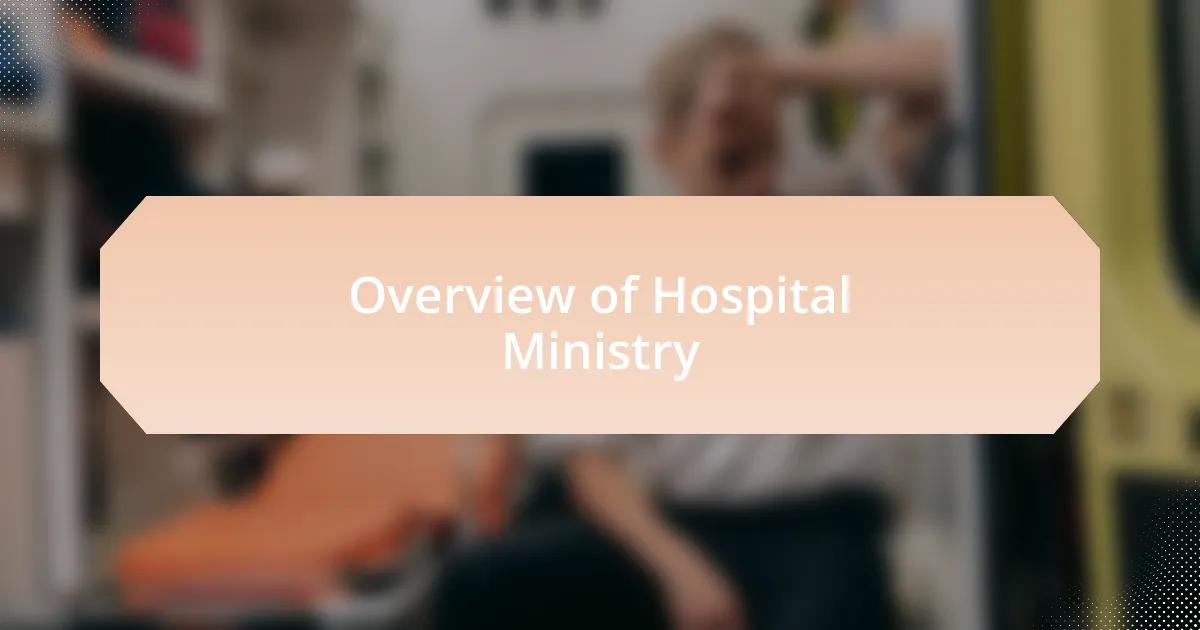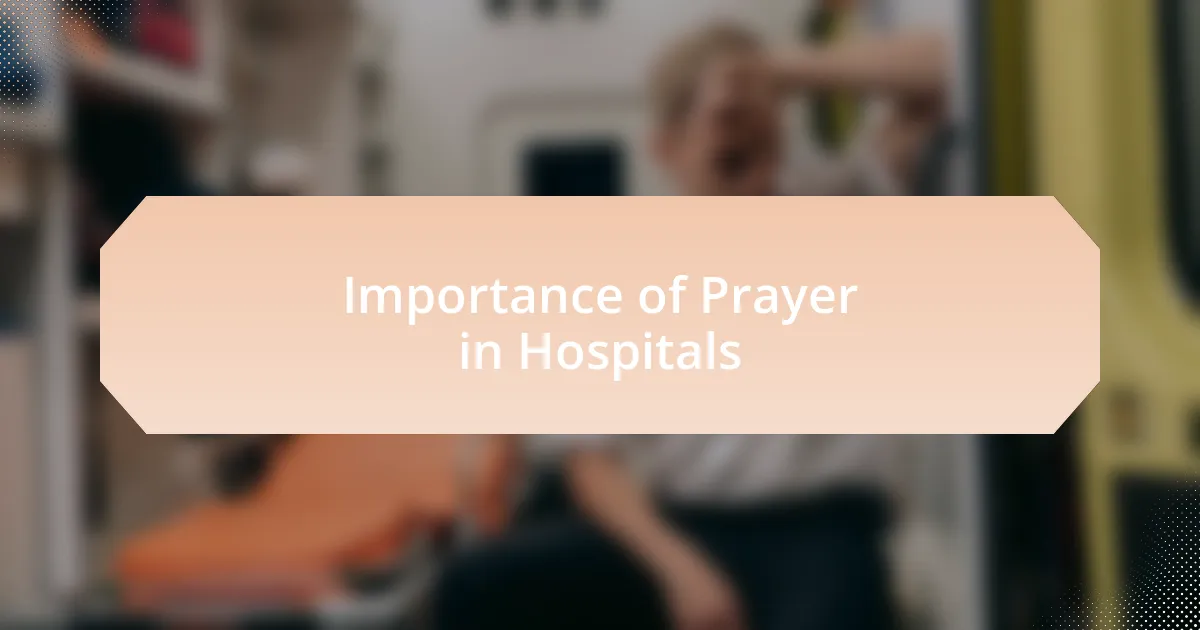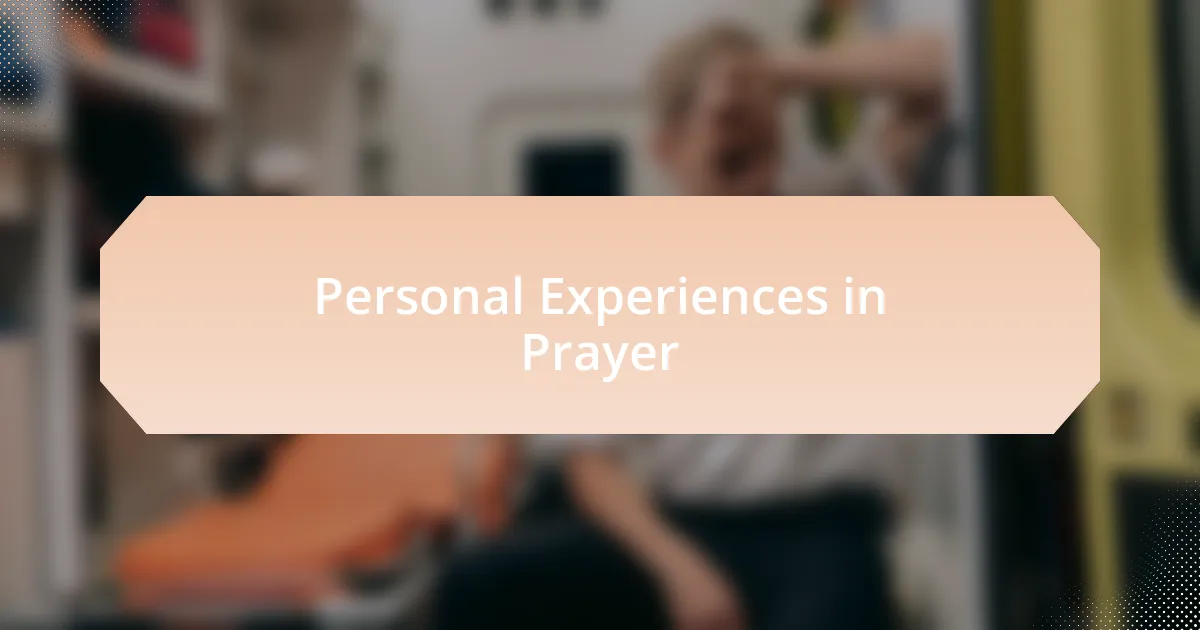Key takeaways:
- Hospital ministry provides vital spiritual support to patients, families, and staff, fostering resilience through prayer and compassionate conversations.
- Prayer serves as a significant source of hope and community, helping individuals cope with challenges, grief, and emotional struggles.
- Creating a dedicated space for prayer and incorporating personal reflections can deepen one’s communication with the divine.
- Building a prayer community enhances spiritual journeys, as shared experiences and diverse voices enrich collective understanding and empathy.

Overview of Hospital Ministry
Hospital ministry plays a vital role in providing spiritual support to patients, families, and hospital staff during challenging times. I remember my first experience in a hospital setting, standing beside a family grappling with a diagnosis that changed their lives forever. It struck me how much comfort a simple prayer or compassionate conversation can bring amidst the chaos of medical terminology and hospital machines.
In this environment, ministry takes on many forms, from one-on-one prayer sessions to leading group discussions that foster community and connection. Have you ever noticed how sharing stories or faith can lighten the burdens we carry? In my experience, these moments create a bridge of understanding and hope, enabling individuals to feel less alone in their struggles.
Moreover, hospital ministry is not just about addressing spiritual needs; it also enhances emotional and psychological well-being. There’s something profound about being present for someone during their darkest hours. I often find that a listening ear or a heartfelt prayer can provoke transformative moments of clarity and peace, reminding us all of the resilience of the human spirit.

Importance of Prayer in Hospitals
Prayer holds a unique power in hospitals, serving as a source of hope and solace for patients and families facing uncertainty. I recall a time when I prayed with a patient who was anxious about an upcoming surgery. The palpable relief in her eyes reminded me that these simple moments can ground us amid fear and anxiety, promoting a sense of peace that transcends our immediate circumstances.
In my experience, prayer can also foster a sense of community among hospital staff. I’ve seen nurses gather in a quiet corner before a shift, taking a moment not just for themselves but also for the patients in their care. Have you ever experienced a moment where collective intention can shift the atmosphere? It’s fascinating how shared prayer can unify a team, enhancing their resilience and compassion as they navigate the challenges of healthcare.
Moreover, prayer can be a profound tool for coping with grief and loss within hospital walls. I once sat with a family after receiving heartbreaking news about a loved one. As we prayed together, it felt as though words of comfort wrapped around them like a warm blanket, providing a sense of connection even in the depths of sorrow. In these difficult moments, prayer becomes a sacred space where hope intersects with heartache, allowing the healing process to begin.

Techniques for Effective Prayer
When engaging in prayer, I’ve found that creating a quiet, dedicated space can significantly enhance its effectiveness. I often choose a specific corner of my room where I feel most at peace. Have you ever noticed how a familiar setting can help center your thoughts? This small adjustment can lead to deeper focus and a more heartfelt conversation with the divine.
In addition, integrating scripture or inspirational readings into my prayers has proven to be a powerful technique for me. Reading a verse that resonates with my current feelings often opens new pathways to understanding and connection during my prayers. I remember a particularly tough day when I read a verse about comfort, and it profoundly shifted my mindset, helping me articulate my hopes and fears more clearly.
Lastly, I’ve discovered that journaling my prayers allows for clearer communication of my thoughts and feelings. Putting pen to paper not only captures my worries but also makes way for gratitude, which I believe is essential. Have you ever reflected on past prayers and noted how certain requests were answered? This practice has not only deepened my faith but also provided tangible evidence of growth and divine presence in my life.

Personal Experiences in Prayer
When I pray, I often reflect on moments when I felt particularly close to God. One instance that stands out for me was during a hospital visit for a friend; I took a moment in the chapel to pray for her healing and the strength of her family. I recall feeling an overwhelming sense of peace wash over me, as if my words were truly echoing in the sacred space. Have you ever felt that profound stillness that reassured you of divine presence?
There are days when my prayers become less about asking for things and more about simple gratitude. I remember one evening, while sitting in my backyard, thanking God for the little joys — the warmth of the sun, the laughter of children playing nearby, and reconnecting with an old friend. In those moments, I realized how powerful it is to thank rather than just petition. What about you? Have you found that gratitude shifts your perspective in prayer?
Another personal experience is when I struggled with a significant life decision. I dedicated a week to focused prayer, asking for clarity. Each day, I felt a subtle nudge in a particular direction—something as simple as hearing a conversation that resonated with my struggles. It became clear that prayer was more about listening than speaking. Do you take time to listen during your prayers? That’s something I now prioritize, as it transforms the experience into a two-way conversation with God.

Building a Prayer Community
Building a prayer community is about creating a safe space where individuals can come together to support one another in their spiritual journeys. I remember attending a small group meeting at my church where we each shared our prayer requests. The atmosphere was charged with vulnerability and trust, and the commitment everyone showed to pray for one another strengthened our bonds. Don’t you think there’s something special about lifting each other up collectively?
When I think about effective prayer communities, I recall a season in my life where our group made it a point to meet weekly, sharing not just requests but also testimonies of answered prayers. Each story added fuel to our faith, transforming our gatherings from mere meetings into heartfelt celebrations of God’s work. Have you ever experienced the joy of hearing how a prayer you contributed to made a difference in someone’s life?
One of the most powerful elements of a prayer community is the diversity of voices and experiences. I once participated in a prayer walk with fellow believers from various backgrounds, and it struck me how our different perspectives enriched our understanding of prayer. Engaging with different views can deepen our collective prayer experience and foster empathy. Have you found that diversity in prayer adds layers of richness to your faith journey?

Integrating Prayer into Hospital Visits
When I visit patients in the hospital, I often find that integrating prayer can create a powerful bond between us. On one occasion, I sat with a woman who was afraid and in pain, and after asking if she would like me to pray with her, her expression shifted from worry to relief. Doesn’t it feel uplifting to see hope rekindled in someone’s eyes through the act of sharing a simple prayer?
In those moments, I’ve learned that prayer doesn’t have to be formal or scripted. Sometimes, I simply speak from the heart, reflecting on the concerns at hand and asking for peace and healing. I recall a young father whose child was undergoing surgery; holding his hand and praying not only provided comfort to him but also reminded me of my own vulnerabilities as a parent. How can we not find common ground when faced with such profound situations?
Incorporating prayer into hospital visits is not just about the words we say; it’s about the presence we bring. During one visit, I asked a patient about their favorite scripture. As they recited it, their face lit up and the room felt lighter. Isn’t it amazing how sharing a personal connection, even through scripture, can transform a clinical setting into a sacred space?